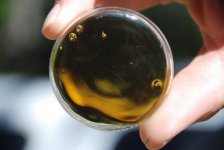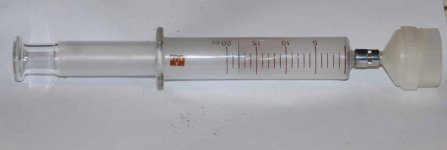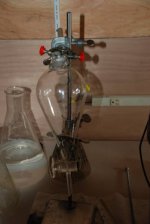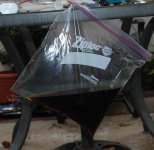Public opinion appears to be split on the salubriousness of including chlorophyll and other plant water solubles in our extracted oils, so this is written not to stir controversy, but specifically for those of ya'll whom do not wish ingredients other than cannabis in your extracts.
Those whom wish to preserve those ingredients are invited to please ignore this posting, rather that debating whether it is a mistake or even a crime against sweet Mary's natural wholeness.
In a nutshell, many of those non cannabinoid ingredients came along for the ride because there was water present and they are water soluble. It is easier to use a process that minimizes their extraction in the first place, but what if that is a moot point, because you already have an extraction with excessive non-active ingredients and wish to remove them?
Next best to a process that doesn't pick up many water soluble ingredients, is one to take them out, so let's talk about a couple processes that we use at skunk pharm:
If the extraction just needs final polishing, we may simply re-dissolve it in 190 proof (~95.5% azeotropic) ethanol and stick it in the freezer overnight at 0F, for the waxes to coagulate and the excess water solubles to precipitate out.
We then carefully decant and filter the alcohol mixture, to remove the coagulated waxes, as well as the chlorophyll, and plant alkaloids which precipitated out as sludge in the bottom of the container.
We routinely use this step to clean up extractions using Isopropyl or Methanol, because they are far more aggressive than ethanol in stripping everything, and much of the non active ingredients fall out when re-dissolved in hot ethanol and subjected to the above step.
It also works well to remove the minor water solubles picked up in a butane extraction, but has its limitations because alcohol is polar and 190 proof is still almost 5% water.
As far as filtering, I prefer a 0.45 micron or a 0.2 micron syringe filter, but got good results with a coffee filter until Joe turned us on to syringe filters. We have picked both the syringes and filters up off of E-bay, as well as from our local scientific supply store.
Now, if we really need to clean up an extraction, we have had good results by re-dissolving the oil in a hot highly non-polar solvent such as hexane and repeatedly washing the solution with saturated salt water until it is mint quality.
You can even skip the re-dissolve step, by just mixing the alcohol extraction with the highly non-polar solvent before evaporating it off, and the alcohol will leave with the first water wash, after the non-polar solvent has stolen away sweet Mary's succulent and titillating charms.
Salt water washing is easy, easier with a separatory funnel, but you can even do it with a few gallon Ziploc bags in pinch, or any number of ways to siphon off, blow off, etc., to achieve that purpose.
To use a Ziploc bag, simply hang by one corner, and clip off the lower corner to drain, pinching to control flow and shut off point.
The way we do it is to start out by making four or five liters of saturated salt water in glass (or ceramic) containers, by mixing sodium chloride (table salt) in hot tap water with a hand mixer until no more will dissolve. We buy the salt cheap by the bag, using salt intended for water softener use.
The magic trick if the alcohol from extraction is still present, is that because the saturated salt water readily accepts the alcohol, but no longer has any room for the water solubles due to its salt saturation, they fall out of solution and are filtered off in bottom sludge or left stuck to the sides of the funnel. If the alcohol has already been removed, the water solubles simply do not dissolve in the Hexane.
The rest of the magic is just as predictable when you mix the polar solvent holding sweet Mary's charms and the lustful non-polar solvent that covets them deeply, given that because of her own polarity, sweet fickle Mary herself lusts after the new suitor, so participates willingly and with a passion.
The alcohol and water are left giggling like idiots and the sludge is probably left puzzled.
To perform the salt water wash of the hexane mixture, simply pour the salt water and hexane into the separatory funnel together in about equal parts and shake well, before allowing the mixture to separate out into layers.
After carefully bleeding off the bottom layer of water, alcohol, and sludge, we replace the salt water that we bled off and shake up the mixture again to mix well. After bleeding that salt water, et al, again, and repeating the procedure several times, the hexane mixture becomes pristine and bell clear.
At that point we stop washing and evaporate off the hexane. While we use HPLC grade hexane from the local science store, naphtha will also work for this process.
To get rid of the hexane, we first evaporating off the visible liquid hexane, and then add 190 proof ethanol to the extracted oil and boil that off. We repeat that procedure several times, until there is no discernible taste or odor of hexane left.
That means that the remaining hexane is below about 30 ppm, which is (~) our sensory threshold perception level. What does that mean as far as our health means?
For starters, because it is a simple Alkane and relatively non toxic, hexane is used extensively in food extraction, but should not be viewed as being as salubrious as mother's milk.
The first clue of course, is that it doesn't come in nearly as attractive a container, and the second is the MSDS information which tells us, that in excess, N-Hexane attacks our nervous system.
OH MAHGAWD, but do check out at what levels this is so and note that oxygen in a breathing atmosphere greater than 75% pure will kill us dead! Poison is in the dosage, so leave us please keep N-Hexane's potential nature in perspective, which includes never losing sight of it!!!!!!
Despite our worst terrors, a review of the hexane Material Safety Data Sheet shows that the oral rat LD50: is relatively high at 25000 mg/kg. At that rate it would take about 4.5 pounds to kill 50% of a population of 180 lb men.
Acute toxicity of the gas (LC50 rat): was 48000 ppm using 4 hours exposure data and the Threshold Limit Value for an 8 hour weighted average in breathing air is 500 ppm with a Permitted Exposure Limit of 1800 mg/M3 (~ppm).
The good news is that if you are out of the stink or taste, you are less than about .01% of TLV, but the bad news (?) is that although it is relatively non toxic, hexane still tastes like lighter fluid below toxicity levels, with our sensory threshold far below the Threshold Limit Value.
Not an unexpected taste treat, because as many of ya'll know, lighter fluid is in point of fact light naphtha, which is a blend of pentane (5 carbon atom chain) and hexane (6 carbon atom chain).
Most of skunk pharm oil goes into oral or topical medications, though some is vaporized. Both the oral and the vaporization applications require residual hexane below human discernable (threshold) perception levels, so out of practicality, we standardized on zero perceptible solvent content on all our oils as just a matter of policy.
Lawrd knows that there are enough people kissing and licking at least some of the more provocative foxes and hunks in our folds all over, that we voted to use the same taste standard for topicals as orals.
The last issue, is of course residue and color, when using topicals! Besides undesirable taste, and non-active bulk in your extractions, there is the pregnant issue of how much residue they leave behind on the skin and how badly they stain our clothes.
Yet another reason to take care in extracting and subsequently processing our topicals, despite the ostensible threshold perception standards being lower.
We could also add that after we have removed the bulk of the non-active ingredients, our oil is more uniform and so our mixing ratios in our menstruums will be more precise and the results more uniform, as a bonus to not leaving a mess on our skin and clothes!
Those whom wish to preserve those ingredients are invited to please ignore this posting, rather that debating whether it is a mistake or even a crime against sweet Mary's natural wholeness.
In a nutshell, many of those non cannabinoid ingredients came along for the ride because there was water present and they are water soluble. It is easier to use a process that minimizes their extraction in the first place, but what if that is a moot point, because you already have an extraction with excessive non-active ingredients and wish to remove them?
Next best to a process that doesn't pick up many water soluble ingredients, is one to take them out, so let's talk about a couple processes that we use at skunk pharm:
If the extraction just needs final polishing, we may simply re-dissolve it in 190 proof (~95.5% azeotropic) ethanol and stick it in the freezer overnight at 0F, for the waxes to coagulate and the excess water solubles to precipitate out.
We then carefully decant and filter the alcohol mixture, to remove the coagulated waxes, as well as the chlorophyll, and plant alkaloids which precipitated out as sludge in the bottom of the container.
We routinely use this step to clean up extractions using Isopropyl or Methanol, because they are far more aggressive than ethanol in stripping everything, and much of the non active ingredients fall out when re-dissolved in hot ethanol and subjected to the above step.
It also works well to remove the minor water solubles picked up in a butane extraction, but has its limitations because alcohol is polar and 190 proof is still almost 5% water.
As far as filtering, I prefer a 0.45 micron or a 0.2 micron syringe filter, but got good results with a coffee filter until Joe turned us on to syringe filters. We have picked both the syringes and filters up off of E-bay, as well as from our local scientific supply store.
Now, if we really need to clean up an extraction, we have had good results by re-dissolving the oil in a hot highly non-polar solvent such as hexane and repeatedly washing the solution with saturated salt water until it is mint quality.
You can even skip the re-dissolve step, by just mixing the alcohol extraction with the highly non-polar solvent before evaporating it off, and the alcohol will leave with the first water wash, after the non-polar solvent has stolen away sweet Mary's succulent and titillating charms.
Salt water washing is easy, easier with a separatory funnel, but you can even do it with a few gallon Ziploc bags in pinch, or any number of ways to siphon off, blow off, etc., to achieve that purpose.
To use a Ziploc bag, simply hang by one corner, and clip off the lower corner to drain, pinching to control flow and shut off point.
The way we do it is to start out by making four or five liters of saturated salt water in glass (or ceramic) containers, by mixing sodium chloride (table salt) in hot tap water with a hand mixer until no more will dissolve. We buy the salt cheap by the bag, using salt intended for water softener use.
The magic trick if the alcohol from extraction is still present, is that because the saturated salt water readily accepts the alcohol, but no longer has any room for the water solubles due to its salt saturation, they fall out of solution and are filtered off in bottom sludge or left stuck to the sides of the funnel. If the alcohol has already been removed, the water solubles simply do not dissolve in the Hexane.
The rest of the magic is just as predictable when you mix the polar solvent holding sweet Mary's charms and the lustful non-polar solvent that covets them deeply, given that because of her own polarity, sweet fickle Mary herself lusts after the new suitor, so participates willingly and with a passion.
The alcohol and water are left giggling like idiots and the sludge is probably left puzzled.
To perform the salt water wash of the hexane mixture, simply pour the salt water and hexane into the separatory funnel together in about equal parts and shake well, before allowing the mixture to separate out into layers.
After carefully bleeding off the bottom layer of water, alcohol, and sludge, we replace the salt water that we bled off and shake up the mixture again to mix well. After bleeding that salt water, et al, again, and repeating the procedure several times, the hexane mixture becomes pristine and bell clear.
At that point we stop washing and evaporate off the hexane. While we use HPLC grade hexane from the local science store, naphtha will also work for this process.
To get rid of the hexane, we first evaporating off the visible liquid hexane, and then add 190 proof ethanol to the extracted oil and boil that off. We repeat that procedure several times, until there is no discernible taste or odor of hexane left.
That means that the remaining hexane is below about 30 ppm, which is (~) our sensory threshold perception level. What does that mean as far as our health means?
For starters, because it is a simple Alkane and relatively non toxic, hexane is used extensively in food extraction, but should not be viewed as being as salubrious as mother's milk.
The first clue of course, is that it doesn't come in nearly as attractive a container, and the second is the MSDS information which tells us, that in excess, N-Hexane attacks our nervous system.
OH MAHGAWD, but do check out at what levels this is so and note that oxygen in a breathing atmosphere greater than 75% pure will kill us dead! Poison is in the dosage, so leave us please keep N-Hexane's potential nature in perspective, which includes never losing sight of it!!!!!!
Despite our worst terrors, a review of the hexane Material Safety Data Sheet shows that the oral rat LD50: is relatively high at 25000 mg/kg. At that rate it would take about 4.5 pounds to kill 50% of a population of 180 lb men.
Acute toxicity of the gas (LC50 rat): was 48000 ppm using 4 hours exposure data and the Threshold Limit Value for an 8 hour weighted average in breathing air is 500 ppm with a Permitted Exposure Limit of 1800 mg/M3 (~ppm).
The good news is that if you are out of the stink or taste, you are less than about .01% of TLV, but the bad news (?) is that although it is relatively non toxic, hexane still tastes like lighter fluid below toxicity levels, with our sensory threshold far below the Threshold Limit Value.
Not an unexpected taste treat, because as many of ya'll know, lighter fluid is in point of fact light naphtha, which is a blend of pentane (5 carbon atom chain) and hexane (6 carbon atom chain).
Most of skunk pharm oil goes into oral or topical medications, though some is vaporized. Both the oral and the vaporization applications require residual hexane below human discernable (threshold) perception levels, so out of practicality, we standardized on zero perceptible solvent content on all our oils as just a matter of policy.
Lawrd knows that there are enough people kissing and licking at least some of the more provocative foxes and hunks in our folds all over, that we voted to use the same taste standard for topicals as orals.
The last issue, is of course residue and color, when using topicals! Besides undesirable taste, and non-active bulk in your extractions, there is the pregnant issue of how much residue they leave behind on the skin and how badly they stain our clothes.
Yet another reason to take care in extracting and subsequently processing our topicals, despite the ostensible threshold perception standards being lower.
We could also add that after we have removed the bulk of the non-active ingredients, our oil is more uniform and so our mixing ratios in our menstruums will be more precise and the results more uniform, as a bonus to not leaving a mess on our skin and clothes!
Attachments
Last edited:





 . This thread comes at a perfect time for me and a buddy, thanks.
. This thread comes at a perfect time for me and a buddy, thanks.








